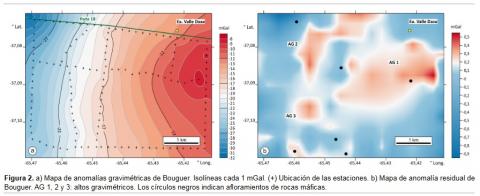Hugo Tickyj, Marcos Emanuel Bahía, Viviana Martínez, Eliana Vanesa Saguas, Renata Nela Tomezzoli, María Alejandra Fernández, José Kostadinoff
2 025
Revista de la Asociación Geológica Argentina, 82(2), 234-242
A geophysical survey was conducted in the Estancia Valle Daza, Utracán Department, La Pampa Province, within a 5 × 4 km area of mining interest due to the presence of critical minerals, including monazite and metagabbros with nickel anomalies. The study involved gravimetry, magnetometry, gamma-ray spectrometry, and electrical self-potential methods and represents a continuation of previous regional geophysical investigations. Residual gravity data revealed three gravimetric highs, spatially associated with bipolar magnetic anomalies reaching up to 300 nT. The largest of these anomalies is oval-shaped, with a major axis of approximately 2 km. These gravimetric and magnetic features are interpreted as responses to mafic rocks, either sub-outcropping or located at shallow depths within the crystalline basement of the study area. Gamma-ray spectrometry identified two zones with equivalent uranium contents of up to 10 ppm, comparable to the levels recorded in granitic mylonites rich in monazite from this sector. Additionally, the self-potential method was applied along a shear zone characterized by granitic mylonites containing monazite, providing further insight into the area's subsurface features. The results of this integrated geophysical approach highlight the value of combining multiple methods to enhance critical mineral prospecting in Estancia Valle Daza.

